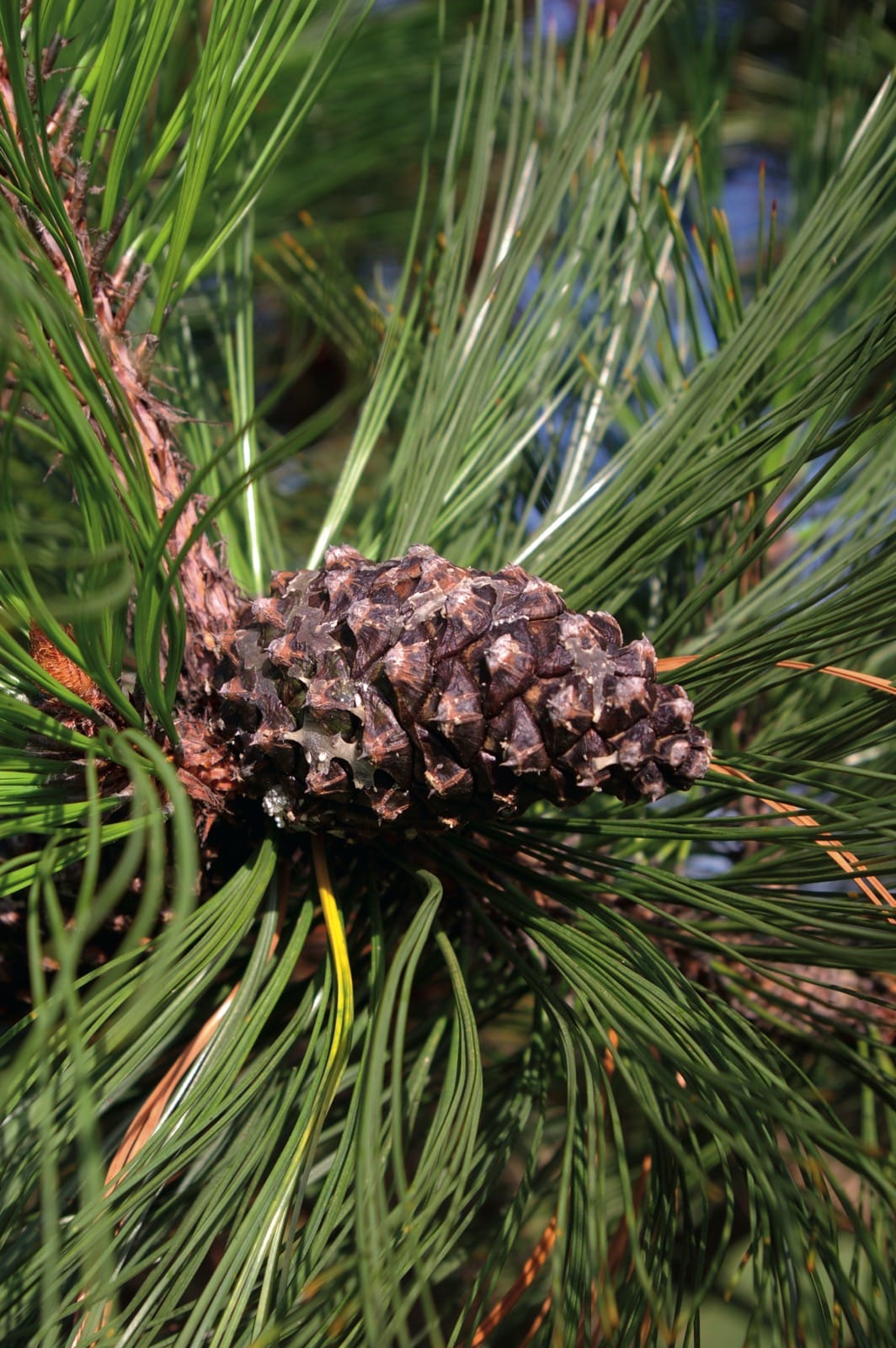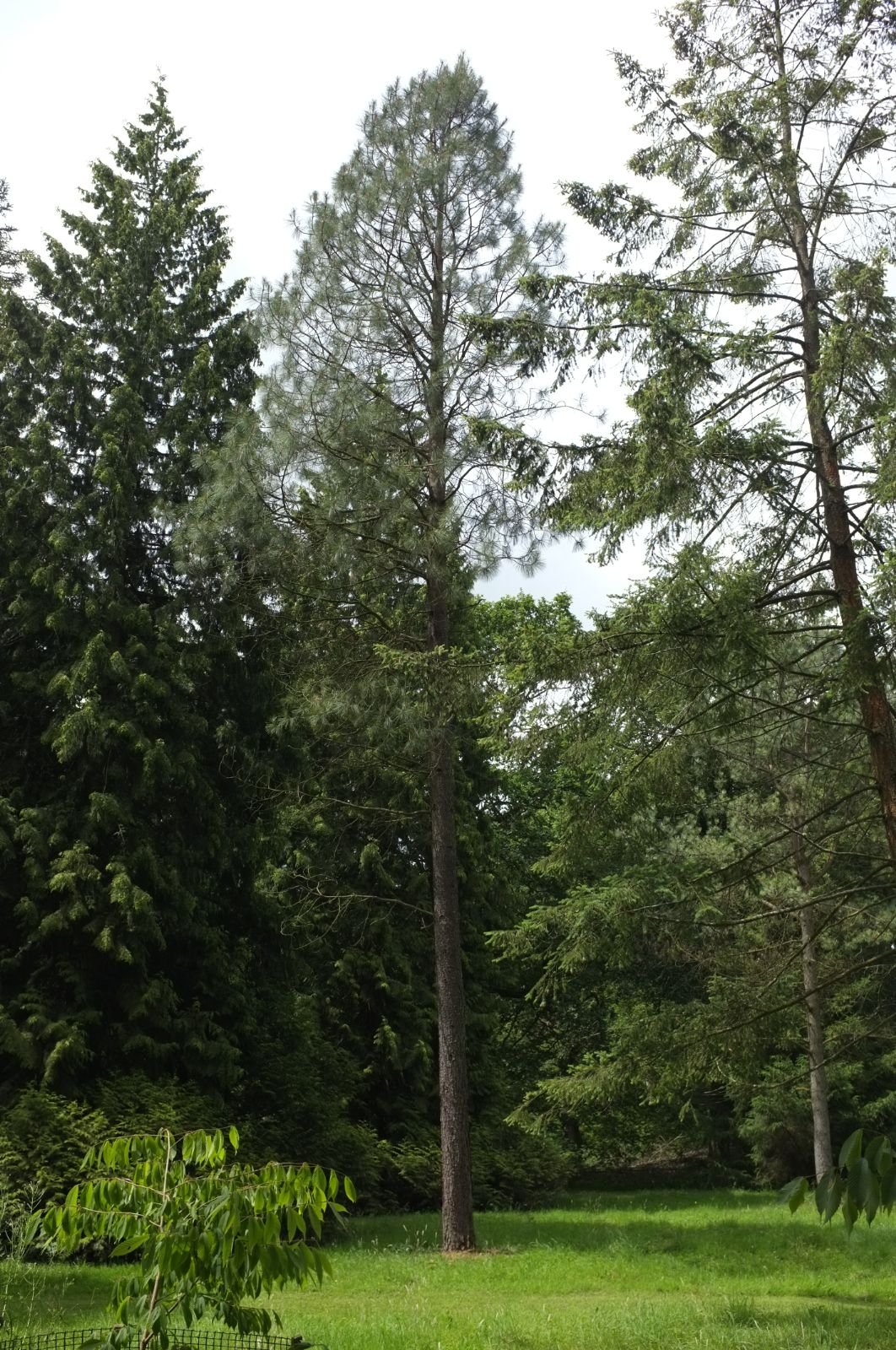Pinus arizonica
Credits
Article from New Trees by John Grimshaw & Ross Bayton
Recommended citation
'Pinus arizonica' from the website Trees and Shrubs Online (treesandshrubsonline.
Genus
- Pinus
- Subgen. Pinus, Sect. Trifolius
Common Names
- Arizona Pine
Synonyms
- P. ponderosa Douglas ex C. Lawson var. arizonica (Engelm.) Shaw
Infraspecifics
Other taxa in genus
- Pinus albicaulis
- Pinus armandii
- Pinus attenuata
- Pinus ayacahuite
- Pinus balfouriana
- Pinus banksiana
- Pinus bhutanica
- Pinus brutia
- Pinus bungeana
- Pinus canariensis
- Pinus cembra
- Pinus cembroides
- Pinus chiapensis
- Pinus contorta
- Pinus coulteri
- Pinus culminicola
- Pinus densata
- Pinus densiflora
- Pinus devoniana
- Pinus durangensis
- Pinus echinata
- Pinus edulis
- Pinus elliottii
- Pinus engelmannii
- Pinus eremitana
- Pinus flexilis
- Pinus gerardiana
- Pinus greggii
- Pinus × hakkodensis
- Pinus halepensis
- Pinus hartwegii
- Pinus heldreichii
- Pinus henryi
- Pinus × holfordiana
- Pinus hwangshanensis
- Pinus jeffreyi
- Pinus johannis
- Pinus koraiensis
- Pinus lambertiana
- Pinus leiophylla
- Pinus longaeva
- Pinus massoniana
- Pinus maximartinezii
- Pinus monophylla
- Pinus montezumae
- Pinus monticola
- Pinus morrisonicola
- Pinus mugo
- Pinus muricata
- Pinus nelsonii
- Pinus nigra
- Pinus oocarpa
- Pinus orizabensis
- Pinus palustris
- Pinus parviflora
- Pinus patula
- Pinus peuce
- Pinus pinaster
- Pinus pinceana
- Pinus pinea
- Pinus ponderosa
- Pinus pseudostrobus
- Pinus pumila
- Pinus pungens
- Pinus quadrifolia
- Pinus radiata
- Pinus remota
- Pinus resinosa
- Pinus rigida
- Pinus roxburghii
- Pinus sabiniana
- Pinus serotina
- Pinus sibirica
- Pinus strobiformis
- Pinus strobus
- Pinus sylvestris
- Pinus tabuliformis
- Pinus taeda
- Pinus taiwanensis
- Pinus teocote
- Pinus thunbergii
- Pinus torreyana
- Pinus virginiana
- Pinus wallichiana
- Pinus wangii
- Pinus yunnanensis
Tree to 35 m, trunk straight and slender, 1–1.2 m dbh. Bark thin, scaly, breaking into a series of large plates; outer bark reddish brown initially, later grey, inner bark reddish brown. Crown open and pyramidal, rounded or flat-topped in mature trees, often above a long, clear bole. Branchlets glaucous or orange-brown; vegetative buds not resinous. Leaves in fascicles of three to five, persisting for three to five years, yellowish green to glaucous, rigid or slightly lax, triangular in cross-section, (8–)10–20(–25) × 0.1–0.2 cm. Fascicle sheaths 1.5–3 cm long, orange- to reddish brown, turning grey-black, persistent. Cataphylls reflexed, 1.5 × 0.3–0.4 cm, dark brown. Male strobili 1.5–2 × 0.5 cm, yellow to yellowish brown. Female cones subterminal; peduncles short, curved, but appearing sessile at maturity. Cones (4.5–)5–10(–14) × 3.5–6(–8) cm, ovoid-globose, asymmetrical, with sharp spines when immature; mature in about 18 months, yellow-brown. Scales 90–140, thick, rigid, rectangular; apophysis usually symmetrical, rhombic to pentagonal, yellowish or reddish brown; umbo dorsal, with a minute, deciduous prickle. Seeds light brown; wings greyish brown, 1.2–2 cm long. Farjon & Styles 1997, Farjon et al. 1997, Farjon 2005a. Distribution MEXICO: Chihuahua, Coahuila, Durango, Nuevo León, Sinaloa, Sonora, northeast Zacatecas; USA: southeast Arizona, southwest New Mexico. Habitat In deep soils in valleys and on mesas between 1300 and 3000 m asl. USDA Hardiness Zone 6. Conservation status Lower Risk. Illustration Farjon & Styles 1997; NT588.
The varieties of Pinus arizonica are distinguished primarily on the basis of a few quantitative leaf characters and these, together with their respective distributions, overlap significantly. The key below is adapted from Farjon & Styles (1997).
| 1a. | Leaves long, thick (14–25 × 0.14–0.18 cm); stomata in 8–12 lines on the lower surface; Mexico (south Coahuila, Nuevo León, San Luis Potosí, Zacatecas) | var. stormiae |
| 1b. | Leaves short or variable, < 0.14(–0.16) cm thick; stomata in 3–7 lines on the lower surface | 2 |
| 2a. | Leaves short (5–12 cm long), in fascicles of (three to) four to five, though usually five; Mexico (Chihuahua, Durango) | var. cooperi |
| 2b. | Leaves variable (8–23 cm long), in fascicles of three to five, though usually three to four; Mexico (Chihuahua, Durango, Sinaloa, Sonora, Zacatecas), USA (southeast Arizona, southwest New Mexico) | var. arizonica |
var. cooperi (C.E. Blanco) Farjon
This variety has shorter leaves than var. arizonica and var. stormiae, (5–)6–10(–12) cm long, in fascicles of three to five, though five-needle fascicles are most common. Farjon & Styles 1997. Distribution MEXICO: Chihuahua, Durango. Habitat As for var. arizonica. Co-occurs with the type variety over part of its range. USDA Hardiness Zone 7. Conservation status Not evaluated. Illustration Farjon & Styles 1997.
var. stormiae Martínez
This variety has longer and thicker leaves than the other two (14–25 × 0.14–0.18 cm) and cones with thinner, flatter scales. There are 8–12 lines of stomata on the lower leaf surface. Farjon & Styles 1997. Distribution MEXICO: southern Coahuila, southern Nuevo León, San Luis Potosí, Zacatecas. Habitat Similar to that of the type variety, though often more arid and at lower altitudes. USDA Hardiness Zone 8. Conservation status Not evaluated. Illustration Farjon & Styles 1997.
Pinus arizonica is closely related to P. ponderosa, but has a more graceful appearance due to its more slender growth and finer needles. No mature examples of var. arizonica were seen in the research for this book, but there is a handsome young specimen on the lawn near the Main Gate at Kew, forming a neatly conical tree of 8–9 m in 2007, with branches to the ground. This was grown from seed collected in the Sierra Madre Occidental in Chihuahua in 1993 by an expedition from the Royal Veterinary and Agricultural University, Hørsholm, Denmark. A plant from the same collection at Arboretum Wespelaar also made an elegant tree, of 6 m, but is unfortunately suffering from dieback at present, caused by the fungal pest Sphaeropsis sapinea (K. Camelbeke, pers. comm. 2007). With its dark green, upward-pointing needles densely covering the branches this is an attractive tree, at least when young (images seen on the internet suggest that it becomes much more open and gaunt with age). It is also grown at Wakehurst Place, from material collected in Chihuahua by Peter Catt, but is less common in cultivation than var. cooperi, at least in the United Kingdom (although none of the varieties are likely to be found outside specialist collections). Var. cooperi has been grown in Britain for some time longer, having been included in the 1962 introduction of several Mexican conifers to the Forestry Commission (Mitchell 1972). There are large individuals in a number of collections, including two trees at Westonbirt (15 m in 2002), and some good specimens at Bedgebury.
Var. stormiae was introduced to cultivation by Michael Frankis on his 1991 visit to Nuevo León (under the numbers M.P. Frankis 143, 163), and trees from this source are growing at Benmore and elsewhere. The cones are quite different from those of var. arizonica, and the taxon may be better treated as a distinct species, as suggested though not validly published by Gaussen (1960); it is also distinct in its long, twisted glaucous grey-green leaves. It is curious that P. arizonica and its varieties have generally slipped by the attention of horticulturists in both Europe and North America, as they appear to be attractive and hardy pines.


